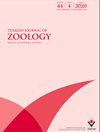Genotoxic effects of oxyclozanide on hemocytes of Galleria mellonella (Lepidoptera: Pyralidae) larvae
IF 1.3
4区 生物学
Q2 ZOOLOGY
引用次数: 0
Abstract
: Oxyclozanide is a salicylanilide derivative anthelmintic drug with a well-known effect on parasites that cause infections in humans and animals. In this study, the effect of oxyclozanide on DNA damage in hemocytes of Galleria mellonella (L.) (Lepidoptera: Pyralidae) larvae, which has been used as a model organism in many fields, was investigated. Hemolymph was collected from the last instar larvae (7th instar) reared on artificial diets containing oxyclozanide at different concentrations (0.003%, 0.03%, 0.3%, and 1.5%) under laboratory conditions and then hemocytes suspension was prepared. Genotoxic damage in hemocytes was determined by the comet assay which enables microscopically detecting DNA damage and is a very sensitive assay in chemical genotoxicity. When compared to the control group, tail length, tail DNA percent, and tail moment values were significantly increased parallel with increasing oxyclozanide concentrations. While the tail length was determined as 5.11 ± 0.46 µm in the control group, it was significantly increased in all tested groups to 13.17 ± 0.53, 27.98 ± 1.08, 98.44 ± 0.77, and 137.67 ± 0.74 µm, respectively. Similarly to tail length, tail DNA percentage and tail moment levels were also significantly increased from 12.86 ± 0.74 to 91.96 ± 0.31 at the highest concentration of oxyclozanide. These results showed that oxyclozanide caused DNA damage in the hemocytes of G. mellonella . It is also known that hemocytes are an important bioindicator in determining the genotoxicity of anthelmintics to be used as insecticides within environmentally friendly limits. It is thought that our results will contribute to the studies in this field.羟考扎尼对蜜梨幼虫血细胞的遗传毒性作用(鳞翅目:梨科)
:氧氯氮平是一种水杨酸苯胺衍生物的驱虫药,对引起人类和动物感染的寄生虫有着众所周知的作用。在本研究中,研究了在许多领域被用作模式生物的鹅膏菌(Galleria mellonella(L.))幼虫血细胞DNA损伤的影响。在实验室条件下,从用含有不同浓度(0.003%、0.03%、0.3%和1.5%)的氧氯化氮的人工日粮饲养的最后一龄幼虫(7龄)采集血淋巴,然后制备血细胞悬浮液。血细胞中的基因毒性损伤是通过彗星测定法确定的,彗星测定法能够在显微镜下检测DNA损伤,是化学基因毒性中非常敏感的测定法。与对照组相比,尾部长度、尾部DNA百分比和尾部力矩值显著增加,与氧氯扎尼浓度的增加平行。虽然对照组的尾部长度被确定为5.11±0.46µm,但所有测试组的尾部都显著增加,分别为13.17±0.53、27.98±1.08、98.44±0.77和137.67±0.74µm。与尾部长度类似,在最高浓度的氧氯氮时,尾部DNA百分比和尾部力矩水平也从12.86±0.74显著增加到91.96±0.31。这些结果表明,羟考扎尼可引起梅洛内拉红细胞的DNA损伤。众所周知,血细胞是确定在环境友好范围内用作杀虫剂的驱虫剂的遗传毒性的重要生物指标。人们认为我们的研究结果将有助于该领域的研究。
本文章由计算机程序翻译,如有差异,请以英文原文为准。
求助全文
约1分钟内获得全文
求助全文
来源期刊

Turkish Journal of Zoology
ZOOLOGY-
CiteScore
2.30
自引率
10.00%
发文量
24
审稿时长
6-12 weeks
期刊介绍:
The Turkish Journal of Zoology is published electronically 6 times a year by the Scientific and Technological Research Council of Turkey (TÜBİTAK).
-Accepts English-language manuscripts in various fields of zoology including systematics, developmental biology, behaviour biology, animal models, molecular biology and molecular phylogeny, genomics, physiology (cell communication and signaling systems), biochemistry and immunohistochemistry, applied parasitology and pathology, nanobiotechnology, ecology, evolution, and paleontology of animal taxa.
-Contribution is open to researchers of all nationalities.
-Short communications are also welcome, such as reports of a preliminary nature or those including new records from specific localities or regions, and the editor reserves the right to decide that a paper be treated as a short communication.
-The papers that deal with purely checklists, new host and non-regional new locality records will not be consider for publication.
-Letters to the editor reflect the opinions of other researchers on the articles published in the journal. The editor may also invite review articles concerning recent developments in particular areas of interest.
 求助内容:
求助内容: 应助结果提醒方式:
应助结果提醒方式:


